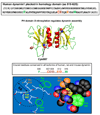The SNO-proteome: causation and classifications
- PMID: 21087893
- PMCID: PMC3040261
- DOI: 10.1016/j.cbpa.2010.10.012
The SNO-proteome: causation and classifications
Abstract
Cell signaling is a complex and highly regulated process. Post-translational modifications of proteins serve to sense and transduce cellular signals in a precisely coordinated manner. It is increasingly recognized that protein S-nitrosylation, the addition of a nitric oxide group to cysteine thiols, serves an important role in a wide range of signaling pathways. In spite of the large number of SNO-proteins now identified (∼1000), the observed specificity of S-nitrosylation in terms of target proteins and specific cysteines within modified proteins is incompletely understood. Here we review the progress made in S-nitrosylation detection methods that have facilitated the study of the SNO-proteome under physiological and pathophysiological conditions, and some factors important in determining the SNO-proteome. Classification schemes for emergent denitrosylases and prospective 'protein S-nitrosylases' are provided.
Copyright © 2010 Elsevier Ltd. All rights reserved.
Figures

References
-
- Hess DT, Matsumoto A, Kim S-O, Marshall HE, Stamler JS. Protein S-nitrosylation: purview and parameters. Nat Rev Mol Cell Biol. 2005;6:150–166. - PubMed
-
-
Ozawa K, Whalen EJ, Nelson CD, Mu Y, Hess DT, Lefkowitz RJ, Stamler JS. S-nitrosylation of beta-arrestin regulates beta-adrenergic receptor trafficking. Mol Cell. 2008;31:395–405. • The authors show that a crucial component of GPCR signaling, b-arrestin 2, interacts with and is S-nitrosylated at a single cysteine by endothelial NO synthase (eNOS).
-
-
- Xu L, Eu JP, Meissner G, Stamler JS. Activation of the cardiac calcium release channel (ryanodine receptor) by poly-S-nitrosylation. Science. 1998;279:234–237. - PubMed
Publication types
MeSH terms
Substances
Grants and funding
LinkOut - more resources
Full Text Sources
Other Literature Sources
Medical

